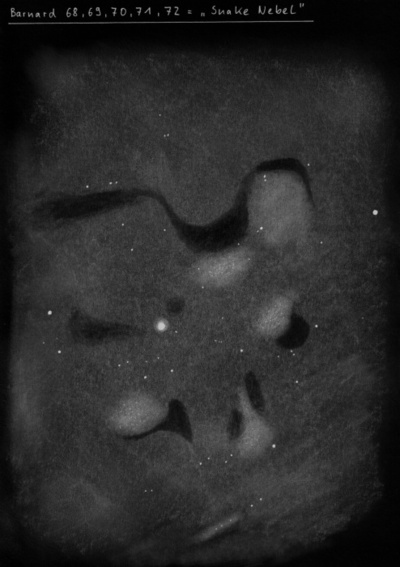A large equatorial constellation of the summer sky, stretching between Hercules and Scorpio. The ecliptic passes through the southern part of Ophiuchus, which is why Ophiuchus is also sometimes referred to as the "13th constellation of the animal". The Sun is here in the first half of December each year, specifically from November 30 to December 17. Ophiuchus lies almost exactly in the middle of the sky: between the north and south poles and between the spring and autumn points.
There are five stars of magnitude greater than three in Ophiuchus, but it's an extremely spread out and uncluttered summer constellation, but well worth exploring with a good map and at least some sort of binocular. In its northeastern part, a split branch of the summer Milky Way extends into it, while its southernmost parts delve into the rich region between Sagittarius and Scorpius, near the centre of the Galaxy. Because most globular clusters are concentrated around it, there are many - over 20 - in the constellation. Ophiuchus also contains typical Milky Way objects such as open clusters, emission and dark nebulae.
The most important and prominent dust complex is the large dark formation Pipe nebula (LDN 1773). Its mouthpiece is clearly visible as a roughly four-degree notch from the eastern side into a less conspicuous, but still easily visible bulge to the west of the Galactic plane. It is formed by the Barnard system of dark nebulae 77, 78, 59, 65, 66, 67 on the borders of Sagittarius, Ophiuchus and Scorpio and transforms in binoculars into a region virtually devoid of any bright stars. Start looking for the pipe about twelve degrees east of Antares at the line of three 3-4mag stars, the only really conspicuous ones in the area. The brightest of these - θ Ophiuchi - lies in the middle of this line. The head of the Pipe is located three degrees SSE of it, the mouthpiece extends two degrees down below θ Oph and terminates three and a half degrees southwest of 36 Ophiuchi, the westernmost star of the line. The globular cluster M19 also lies a short distance to the VSV.
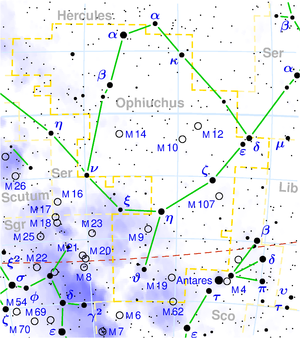
The plume, by the way, forms the hind legs and part of a much larger dark structure that has come to be referred to as the Dancing Horse, especially in Anglo-American countries. It can be found roughly midway between M24 and the star Antares and is easily seen, especially with the naked eye. The whole complex consists of the following parts: Barnard 64 and 259 (the nostrils of the horse), B 268 and 270 (the mane), B 47, 60 and 63 (the forelegs and the kupyto), B 262, 266 and 269 (the lower parts of the forebody), B 77 (the abdomen), B 78 (the hind part) and finally B 65-67 (the hind legs). The rider starts still in Ophiuchus and ends in Sagittarius near Trifid. We'll play with the dark nebulae some more. The surrealistically long extension of the horse's foreleg, winding down to the ρ Ophiuchi complex, also represents the so-called Dark River (B 44, 45, 46, 47, 51, 60, 253). This begins roughly at the star 22 Scorpii, is about half a degree wide and ten degrees long, gradually widening into a breaking chain of dark regions. All the while, this huge physically related complex is one of the darkest. The incoming starlight is dimmed by up to 30 magnitudes in some places. That's enough to keep us from seeing a massive supernova explode!
In the northern part of the constellation, the brightest part of the Milky Way is around the open cluster NGC 6633, which is visible to the naked eye as a distinctive circular spot. To the east of it is the angularly larger but less conspicuous cluster IC 4756, which may also be visible without binoculars. Stellar clusters 66, 67, 68, 70 and 73 Ophiuchi are arranged in a small V-shape. This is Poniatowski's Taurus, an old but no longer extant constellation introduced in 1777. To the northeast of it, and next to the star β Ophiuchi, lies another open cluster - IC 4665. To the naked eye, it appears as an unmissable moon-sized hazy spot on the edge of the Milky Way.
Ras Alhague (α Oph) - With its 2nd magnitude, it is the brightest star in the constellation. Ras Alhague is located at the northern edge of the constellation and is not very far from a star with a similar name, α Herculis, the main star of Hercules. It is a yellow-white giant star located 48 light-years away from us. This distance is constantly increasing due to its motion of 8 km per second.
λ Oph - A nice double star with a period of 130 years. Its components have magnitudes of 4.2 and 5.2 and are separated by 1.5". One of them has a white color, while the other has a light yellow color. At a larger separation, we can also observe two additional, probably optical companions with magnitudes of 9.5 and 11.1.
70 Oph - A binary star consisting of two stars with magnitudes of 4.2 and 6 has a mutual orbital period of 87 years. The orbital path has such a spatial position that the apparent angular separation of the two stars significantly changes during the orbital period. The smallest separation (1.5") was reached by both stars in 1989 and 1990. At the turn of the millennium, their separation increased to 3.9", which could be observed even with a telescope with a 5 cm diameter objective. In 2005, the distance increased to 5". The largest separation of 6.8" will be reached by both stars in 2024.
ρ Oph - A binary star located 3° northwest of Antares, consisting of blue components with magnitudes of 5.3 and 6, separated by 3.1" (4.59 mag). The area around them is interesting for photographers. To the west, there is an elongated dark nebula Barnard 42, which appears as a silhouette against the beautiful gas and dust complex IC 4604, illuminated by the star ρ Ophiuchi. However, the nebula has a very low surface brightness.
36 Oph - A beautiful double star with equally bright orange components of magnitude 5.1, separated by 4.9" and distinguishable even in smaller telescopes. At a larger separation from it, an orange companion of magnitude 8.1 is visible to the northwest.
τ Oph - A binary star, which consists of a beautiful but close pair of yellow stars with magnitudes of 5.2 and 5.9, respectively, and a period of 280 years. Currently, their separation is about 1.7", but it is still decreasing. At a distance of 100", we can find a guide star with a brightness of 9.3 mag.
RS Oph - Recurrent nova, which gradually flared up in the years 1898, 1933, 1958, 1967, and 1985. It has a minimum brightness of 11.8mag and can flare up to 4.3mag.
Keplerova supernova - The last galactic supernova, which erupted on September 9, 1604. It is named after a famous German astronomer who observed it at that time. It was visible to the naked eye for 12 months and several weeks, and its brightness of -2.5mag surpassed even the planet Jupiter. Johannes Kepler and David Fabricius determined its position with such precision that the German-American astronomer Walter Baade could identify a faint nebula, the remnant of the supernova, in the same location in 1943. The star itself is now fainter than 19mag and can only be observed with the largest telescopes. Its remnant was also revealed by the Hubble Space Telescope.
Barnardova hviezda - These interesting red stars, visible only through a telescope, move the fastest of all against the background of more distant stars - they shift by 10.31" per year, which means they change their position by the diameter of the Moon in 180 years. Sometimes they are also referred to as Barnard's arrow. Among all known stars, they have the largest proper motion, which was discovered by E. Barnard in 1916. After the Alpha Centauri system, they are the second closest star to our Sun, only 5.9 light-years away, which is also the main reason for their fast motion across the sky. Barnard's arrow is still approaching us, and in the year 9700, when it will be located in the head of Draco, it will be only 3.8 light-years away from us! Tracking its motion can be a very interesting activity. By drawing its position in the star field at least once a year with a higher magnification, we can see it for ourselves.
M 19
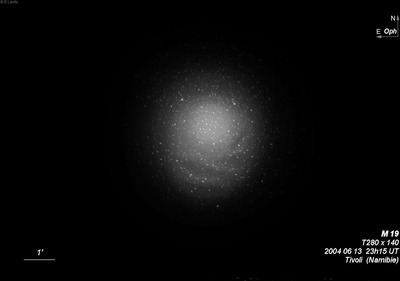
Charles Messier discovered M19 = NGC 6273 = h1975 = h3663 on 5 June 1764 and reported a "Nebula without stars, on the parallel of Antares between Scorpius and the right foot of Ophiuchus: this nebula is round; one can see it very well with an ordinary telescope of 3.5-foot focal length."
William Herschel first resolved the cluster using his 6-inch (10-foot focal length) on 28 May 1783, before his sweeps began. "I can count 5 or 6; & all the rest of the light appears mottled like other nebulas when not sufficiently magnified and illuminated to shew the stars." John Herschel, observing from Slough on 16 Apr 1828, recorded "a fine globular cluster, stars vS, 12...18m, with one = 10m, and one 10-11m; nearly R; vgpmbM, but does not come up to a blaze. Insulated; 3' diam. It forms a link between I. 70 [NGC 5634] and M10 or M12."
200/250mm - 8" (7/17/82): lively, two or three very faint stars are resolved at the north edge.
300/350mm - 13.1" (7/27/84): bright, elongated N-S, very mottled, brighter core. The outer edges barely resolves into one or two dozen stars at 220x.
13.1" (7/17/82): a number of faint stars just resolve at 280x, particularly around the south edge.
400/500mm - 17.5" (6/3/00): bright, moderately large globular, unusual appearance with an extended halo ~6'x4.5' (elongated N-S) and a bright 3.5' core. The cluster breaks up into several dozen stars at 220x and at 500x at least 50 stars are resolved over the entire face of the globular. There are a couple of strings of stars on the SE side of the halo with a dark lane between the strings. The brightest star (foreground?) is on the northeast side.
Notes by Steve Gottlieb
M 12
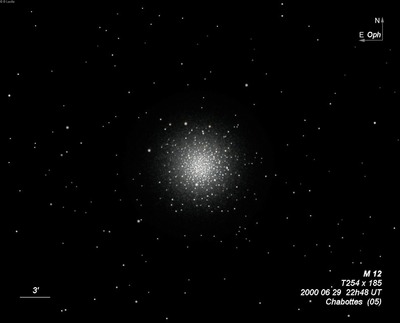
Charles Messier discovered M12 = NGC 6218 = h1971 on 30 May 1764. Johann Bode independently found M12, along with M10, on 14 Aug 1774. William Herschel first observed the globular on 21 May 1783, along with several other clusters, using his 8-inch (10-ft focal length) reflector and noted a "cluster of close stars of different sizes." Using his 18.7-inch (20-ft focal length) on 3 May 1786 (sweep 562), he recorded "a beautiful cluster of very compressed and vS stars; they are however of various magnitudes. The most compressed part takes up about 2'; the whole not less than 7 or 8'. Very gradually most compressed in the middle."
On 15 Apr 1828 (sweep 146), John Herschel called M12 a "v rich globular cluster. The stars 10...16m; vgmbM, but has stragglers in lines and branches extending some distance from the condensed part, which is 3' diam. Comes almost to a blaze in the middle, and has a * 10-11m in the centre." His first observation was on 30 May 1821, while just learning how to sweep.
200/250mm - 8" (6/19/82): the outer halo is well resolved and partial resolution of the core. There are two or three brighter stars in the outer halo.
300/350mm - 13.1" (6/19/82) : bright, large, round, very intense core with faint stars scattered over the core. The outer halo is highly resolved into scores of stars. Slightly inferior to M10 in faint stars.
400/500mm - 17.5" (7/15/99): at 220x this bright cluster is highly resolved over the entire disc. Appears smaller than M10, perhaps 11'-12' diameter with a fairly well-defined 3.5' core. Two bright field stars are embedded in the north edge of the halo and a third bright star is off the following end. A mag 10 star is also superimposed just off the SE edge of the core. A number of brighter resolved mag 12 stars appear to be grouped into pairs and trios. There are a couple of hundred fainter stars in the central 8' over unresolved haze. The outline is very irregular and there are distinctive star-poor areas in the outer halo.
Notes by Steve Gottlieb
M 62
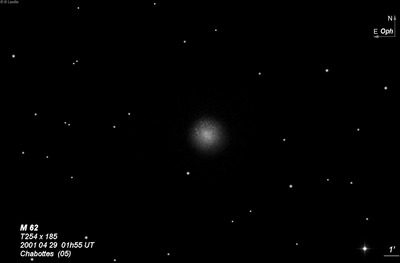
Charles Messier discovered M62 = NGC 6266 = D 627 = h3661 on 7 June 1771 and described a "very beautiful nebula, discovered in Scorpio, it resembles a little Comet, the centre is brilliant & surrounded by a faint glow."
William Herschel first observed the globular on 28 May 1783 with his 6-inch (10-foot telescope) and noted "With 250 power, a strong suspicion, amounting almost to a certainty, of its consisting of stars. In observations with his 18.7-inch (20-foot telescope) in 1785 and 1786, he called the cluster "Extremely bright, round, very gradually brighter in the middle, about 4 or 5' in diameter; 240 power with strong attention showed the stars of it. The cluster is a miniature of the 3d of the Connoissance."
On 8 May 1834, John Herschel was the first to note its off-center core: "globular, vB, L, R, pgvmbM, perfectly resolved with left eye, hardly with right. The most condensed part is a perfect blaze, but not quite in the centre. The southern part runs out further. A beautiful object (See figure 13, Plate VI). [Semi] Diam = 13.5 seconds in RA."
Using the Great Melbourne Telescope on 8 Oct 1874, Joseph Turner called it a "superb object and almost a miniature of Omega Centauri". He noted "this condensed portion is not quite central, but (offset) toward the north-following side, the cluster branching out considerably in the south-preceding direction."
200/250mm - 8" (6/19/82): bright nucleus, nonsymmetrical appearance, fans out to the west from an off-center core. A few very faint stars are resolved at the west edge.
300/350mm - 13.1" (6/19/82): very bright nucleus, asymmetric appearance with a flattened SE region. The outer halo is very mottled and just resolved into many faint stars at 220x.
400/500mm - 18" (7/9/02 - Magellan Observatory, Australia): at 171x this is a very striking globular set in a fine star field. The halo is very irregular and elongated due to a flattening along the SE side. The halo is easily resolved into several dozen faint stars, many in strings and chains. A long string of stars extends from a mag 10.5 star off the SE side along the east edge of the halo. The center appears offset due to the flattening and is very compressed with a large, blazing core.
Notes by Steve Gottlieb
M 10
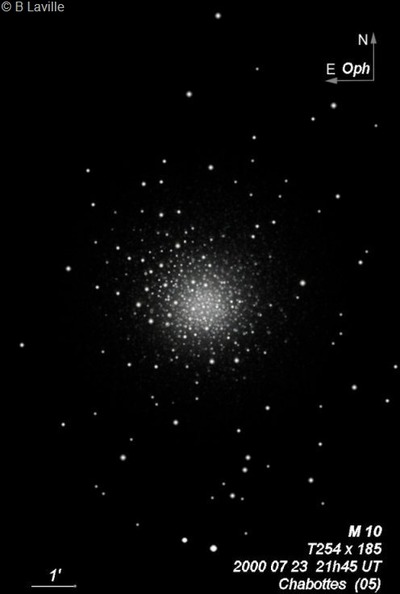
Charles Messier discovered M10 = NGC 6254 = h1972 on 29 May 1764. William Herschel first observed the globular on 21 May 1783 with his 8-inch (10-ft focal length) and noted "With 227 I suspected it to consist of stars; with 460 I can see several of them, but they are too small to be counted." In 1784 and 1791 he observed M10 with his 18.7-inch and noted "A beautiful cluster of extremely compressed stars; it resembles the 53d [M53]; and the most compressed part is about 3 or 4 minutes in diameter."
On 1 Jun 1831 (not registered as a sweep), John Herschel logged, "a superb cluster of very compressed stars, gbM. The stars are 10...15m, and run up to a blaze in the centre, but I see no nucleus. Diam about 6'; a noble object." His first observation was on 30 May 1821, the second night he was learning how to sweep.
200/250mm - 8" (6/19/82): bright lively core highly resolved. The outer halo is highly resolved with several long, distinct streamers.
300/350mm - 13.1" (6/19/82): very bright, fairly large, intense core richly covered with fairly bright stars. Scores of stars are resolved in the outer halo.
400/500mm - 17.5" (7/15/99): beautifully resolved at 220x. The halo appears to extend to nearly 14' although the star density is very low in the outer edge of the halo. The inner halo is sharply concentrated with a very bright 5'x4' core which is elongated SW-NE. The cluster is highly resolved into mag 12/13 stars from edge to edge (too numerous to count) with the stars very densely packed over the core. A second layer of mag 13/14 stars is superimposed over the core. The halo contains a number of strings including a long string to the south which curves east and a string to the north which curves west. Also two parallel linear strings head north or NNE from the core.
Notes by Steve Gottlieb
M 14
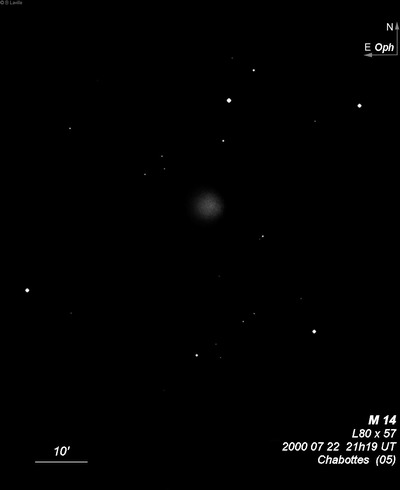
Charles Messier discovered M14 = NGC 6402= h1983 on 1 June 1764 and noted a "Nebula without star, discovered in the garb which dresses the right arm of Ophiuchus, and situated on the parallel of Zeta Serpentis: This nebula is not large, its light is faint, one can see it nevertheless in an ordinary telescope of 3.5-foot [FL]; it is round, near it is a small star of 9th magnitude."
William Herschel, observing with his 12-inch (small 20-foot) on 23 Jul 1783, noted "With a power of 200, I see it consists of stars. They are better visible with 300. With 600, they are too obscure to be distinguished, though the appearance of stars is still preserved. This seems to be one of the most difficult objects to be resolved. With me, there is not a doubt remaining; but another person, in order to form a judgment, ought previously to go through all the several gradations of nebulae which I have resolved into stars." On 25 May 1791 (sweep 1010), he recorded with his 18.7-inch, "eB, R, easily resolvable. With a power of 300 I can see the stars. Resembles the 10th of the Connoiss. which probably would put on the same appearance as this, if it were off half as far again as it is."
On 30 May 1821, his second night of being instructed how to sweep and record objects, 29-year old John Herschel logged M14 as "a globular cluster of excessively small stars, barely but certainly resolved with the examining power and difficult with the sweeping power, brighter in the middle." The sweep was registered out of order in his Slough Catalogue as sweep 54.
300/350mm - 13" (7/5/83): fairly large, broad concentration. About a dozen very faint stars are resolved across the disk. The outer halo fades out smoothly.
400/500mm - 17.5" (7/1/00): this bright, large, fairly symmetric globular appears elongated ~E-W and ~7'x5' in size at 220x. The bright core is relatively large at 4', very lively and granular with a layer of very faint stars. At 280x, ~30 stars are resolved in the small halo and at the edge of the intense core. A rich, even sprinkling of faint stars cover the core. It was difficult to count the resolved stars as numerous dim stars pop out with averted vision over the bright background haze, but perhaps 60-70 stars in total were glimpsed.
17.5" (7/16/88): bright, large, 25-30 very faint stars are resolved mostly at the edges which have a ragged appearance.
600/800mm - 24" (7/30/16): at 432x; very bright, large, nearly fills the 10' field. The outer halo is resolved into dozens of star, perhaps 50 or 60 total. The relatively large core is plastered with tiny resolved stars; roughly 50 additional stars were resolved over a lively background, so overall at least a 100 total though difficult to count due to density and the bright background glow. The outer halo is slightly elongated E-W as well as the core, but the overall appearance is symmetrical. The core only exhibits a broad, weak concentration.
Notes by Steve Gottlieb
M 9
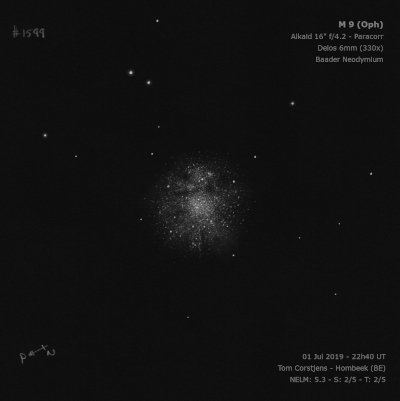
Charles Messier discovered M9 = NGC 6333 = h1979 on 28 May 1764 and recorded a "Nebula, without star, in the right leg of Ophiuchus; it is round and its light is faint. Diam. 3 arc-minutes".
William Herschel first observed this globular on 3 May 1783 with an 8-inch (10-foot focal length) and noted, "With a power of 250, I see several stars in it, and make no doubt a higher power, and more light, will resolve it all into stars. This seems to be a good nebula for the purpose of establishing the connection between nebulae and clusters of stars in general." Using his 18.7-inch on 18 June 1784 (sweep 230) at 157x, he recorded "A vL and vB cluster of excessively compressed stars. The stars are but just visible, and are of unequal magnitudes: the large stars are red; and the cluster is a miniature of [M53]. Again on 28 May 1786, he reported "a cluster of extremely compressed, excessively small stars, with a very few scattered one chiefly to the north of it."
200/250mm - 8" (6/19/82): very mottled, few stars resolved at edges at high power especially on the east side. Dark nebula B64 is close SW. NGC 6356 lies 75' NE and NGC 6342 75' SSE.
300/350mm - 13.1" (6/19/82): the central region is very bright and mottled. A number of faint stars are resolved in the outer region of the core at 150x as well as a number of stragglers.
400/500mm - 17.5" (8/1/92): at 220x, bright, fairly large, 4' diameter. The bright core is elongated N-S somewhat like M4. The outliers or unrelated field stars appear to extend the halo E-W. The halo is fairly well resolved into two dozen mag 13.5-14.5 stars. The core is very mottled and lively and just breaks up into numerous, densely packed mag 14-15 stars. At 420x, the core is easily well-resolved and two very close double stars are at the west and east edges of the halo. The dark nebula B64 lies close SW.
Notes by Steve Gottlieb
M 107
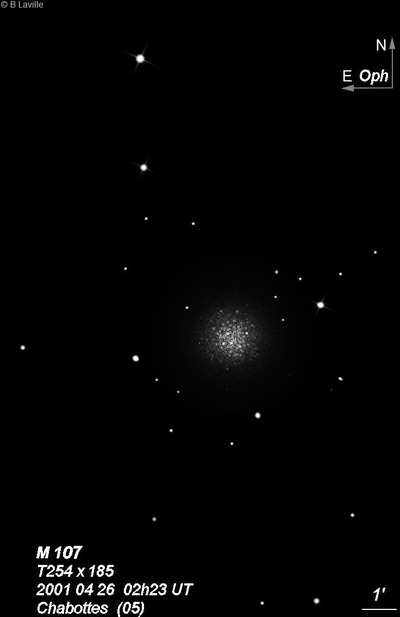
15x50 IS binoculars: faint but not difficult.
Pierre Méchain discovered M107 = NGC 6171 = H VI-40 = h3637 in April 1782. It was discovered after Messier's final catalogue was sent to publication but was included in a letter dated 6 May 1783 to Johann Bernoulli, the editor of the Berliner Astronomisches Jahrbuch and published in the 1786 Jarbuch volume. Mechain wrote "In April 1782 I discovered a small nebula in the left flank of Ophiuchus between the stars Zeta and Phi, the position of which I have not yet observed any closer." This was the last of Mechain's discoveries.
William Herschel rediscovered the globular on 12 May 1793 (sweep 1043) and called it "a very beautiful extremely compressed cluster of stars, extremely rich, R, about 5 or 6' dia, gradually more compressed toward the center." It was found again by Karl Harding around 1823 and reported as new. John Herschel, observing from the Cape of Good Hope on 5 Jun 1836, recorded "Globular; v rich; gpmbM; diam in RA = 20.0s; that of the most compressed part 4.5s; stars well separated."
200/250mm - 8" bright core, fainter halo, mottled. A few stars are visible at the northwest edge.
300/350mm - 13" (6/19/82): bright core with several faint stars resolved in the halo and a few stars resolved at the edge of the core.
400/500mm - 17.5" (7/10/99): this bright globular was well resolved at 220x, with a ~5'x3' halo elongated in an E-W orientation although the sharply defined core is circular and ~2' in diameter. Enclosing the globular on the west, east and south sides are brighter mag 11.5-12.5 stars. Roughly 30 stars are scattered throughout the outer halo at 280x and a couple of dozen densely packed stars overlay the core of the globular in steady moments.
Notes by Steve Gottlieb
NGC 6309
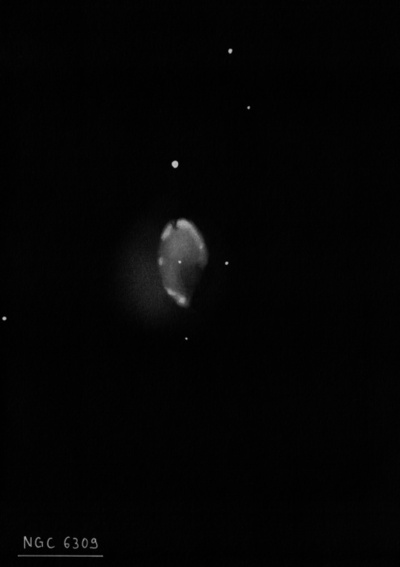
Wilhelm Tempel discovered NGC 6309 = T I-46 = T V-31 in 1876 using the 11" refractor at the Arcetri Observatory in Florence. He only gave a rough position in his first discovery list I (AN 93, p. 59) but measured an accurate position in 1879 that was published in his fifth list. Edward Pickering found the planetary on 15 Jul 1882 with the 15-inch refractor at Harvard College Observatory using a direct-vision spectroscope and noted "nebula found by Tempel (GC 4851). Tempel's description 'between 2 stars' does not seem applicable." There is only one close star. Herbert Howe described NGC 6309 as a close double nebula, using the 20-inch refractor in Denver. NGC 6309 is the only planetary discovered by Tempel. Both this planetary and NGC 6445 are referred to as the "Box Nebula".
Based on Crossley photographs at Lick, Curtis (1918) reported "at first sight this nebula appears binuclear, but the southern condensation is not stellar. Quite irregular; about 19"x10" in p.a. 163°. The southern condensation is 7.5" from the central star."
300/350mm - 13.1" (7/27/84): moderately bright, small, elongated NNW-SSE. A mag 12 star is at the NNW edge 20" from the center. Appears slightly brighter or a condensation is at the SSE end.
400/500mm - 17.5" (6/30/00): at 280x using a UHC filter, this bright but compact PN was elongated 2:1 in the direction of a 12th magnitude star at the NNW edge, with dimensions of ~25"x12". There is a large, bright lobe or condensation at the north end with a smaller, fainter knot at the SSE end. At moments the lobes appear completely "resolved" with a darker gap in the center. The view at 500x was excellent! The fainter southern lobe appears elongated and slightly offset from the major axis of the PN. The lobes are bisected by a darker lane oriented SW-NE and oblique to the minor axis. The brighter knot at the north end has a mottled appearance and irregular shape.
600/800mm - 24" (8/13/15): this very bright, bipolar, compact planetary was viewed at 375x and 500x. The two lobes are extended at least 3:2 NNW-SSE with an overall size of ~25"x16" and a pear shape. A bright, roundish lobe is on the NNW side and a 12th magnitude star is off this side in the direction of the major axis [22" from center]. The smaller lobe on the SSE end is slightly fainter and separated by a small darker gap near the center. A mag 15 star is just off the west edge [14" from center]. An extremely faint outer shell or extension was just visible bulging out on the east side perhaps 10", creating an asymmetric appearance.
24" (7/16/15): excellent view at 450x unfiltered. The larger and brighter lobe on the north-northwest end appeared roughly circular and slightly brighter along the outer rim. The smaller knot on the south-southeast end is slightly irregular and the nebulosity dims near the center. A mag 12 star is just north of the north-northwest end.
Notes by Steve Gottlieb
NGC 6633
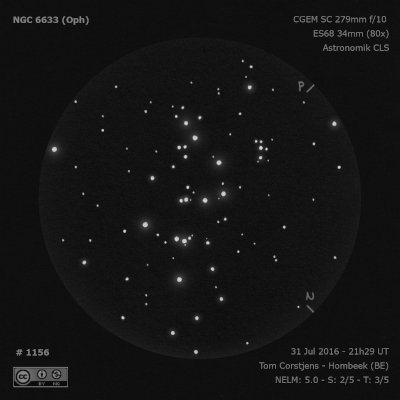
Philippe Loys de Chéseaux discovered NGC 6633 in 1745-46. Caroline Herschel rediscovered the cluster on 31 Jul 1783. She wrote, "About halfway from S Serpentarii [Ophiuci] towards Theta Serpentis, a cluster of large stars. I counted about 80. Messier has it not." On 30 Jul 1788 (sweep 850), William Herschel called it "a coarsely sc. cl. of L stars."
300/350mm - 13.1" (9/9/83): very bright, very large but loose and scattered. At 62x, 150 stars are visible in a 60' field with several bright stars on the SW side and many bright stars are outside this field including mag 5.5 SAO 123516 15' SSE. This is a naked-eye open cluster in dark skies.
Notes by Steve Gottlieb
NGC 6572
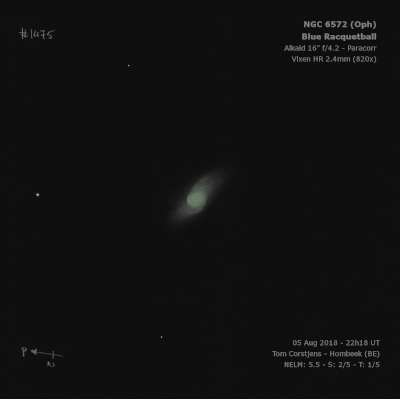
Wilhelm Struve discovered NGC 6572 = ∑ 6 = h2000 on 18 Jul 1825 with the 9.6" Fraunhofer refractor at the Dorpat Observatory. It was included in his list of 9 "Nebulae detectae" in an appendix to his main catalogue of double stars, which was published in 1827. According to Wolfgang Steinicke, Bessel earlier measured NGC 6572 in 1822 during his "Zone observations" at Konigsberg, but didn't mention it as being nebulous.
John Herschel first observed this planetary on 9 May 1828 and recorded "a beautiful round, perfectly well defined and brilliant disc, equally a star 8-9 mag. White equably bright. Well seen in broad morning twilight. A * 9-10m follows, 2' dist. The sweeping power shows it as a * of large diameter, which could not escape examination in a good night; with 240 the disc seen as described. It cannot be more than 4" diameter." On 19 Aug 1830, JH showed the planetary to Wilhelm Struve at Slough. Auwers made several measurements of the size, including 6.4"x5.3", and Secchi (1856) measured it at 7.5"x7.2" and noted a brighter center. At Birr Castle, the color was described as "very blue".
Based on Crossley photographs at Lick, Curtis (1918) reported NGC 6572 as "an oval disk, fading out slightly towards edges, 14"x9" in a 5 min exposure and 16"x13" in the long exposure. No structural details visible."
200/250mm - 8" (7/79): bright, small, very high surface brightness.
300/350mm - 13.1" (8/24/84): very bright, small, about 15" diameter, slightly elongated N-S, extremely high surface brightness, blue color. Very faint outer halo is elongated N-S. No central star seen.
400/500mm - 17.5" (6/3/00): at 220x appears as a very bright, small, intense blue oval, ~15"x12". At 280x-500x, a thin outer envelope is obvious with the inner oval a uniform high surface brightness. No central star visible.
600/800mm - 24" (9/1/16): at 200x, 375x and 500x; extremely high surface brightness, saturated blue-green disc slightly elongated oval N-S, perhaps 14"x10". A very thin shell appears to encase the disc and occasionally an extremely low surface brightness outer halo appears to extend mostly north and south.
900/1200mm - 48" (4/4/11): I only took a quick look at this colorful planetary in the 48-inch at the end of the last night when the seeing the poor, but I could tell the very high surface brightness blue/green component was surrounded by much fainter outer halo that appeared slightly pinkish!
Notes by Steve Gottlieb
NGC 6369
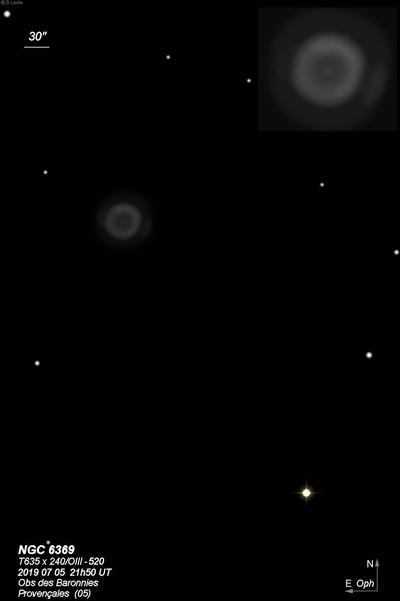
William Herschel discovered NGC 6369 = H IV-11 = h1981 = h3686 on 21 May 1784 (sweep 222) and recorded "a curious round, tolerably defined pB nebula 30 or 40" in diameter." On 26 May 1786 (sweep 566), he called it "pB, R, S, of equal brightness throughout." From the Cape of Good Hope, John Herschel gave a detailed description: "Annular Nebula. Exactly round; pF; 12" diameter; well terminated; but a very little cottony at the edge, and with a decided darkness in the middle; = a * 10m at the most. Few stars in the field [situated in the bowl of the Pipe Nebula!]; a beautiful specimen of the planetary annular class of nebulae." His published sketch is on Plate VI, figure 4. Joseph Turner also sketched the planetary in Sep 1874 using the Great Melbourne Telescope (unpublished plate VII, figure 76).
Based on Crossley photographs at Lick, Curtis (1918) described NGC 6369 as "a regular, nearly round ring, slightly longer in p.a. 120°; much fainter at the eastern end of the major axis and brightest at the north. Diameter 28" center of ring perfectly blank. Quite faint; the ring just shows in 10m on S27. The central star is magn. 16."
John Mallas coined the nickname "Little Ghost" in his Apr/May 1963 article "Visual Atlas of Planetary Nebula-IV", published in the "Review of Popular Astronomy".
300/350mm - 13.1" (8/5/83): use at least 220x to clearly resolve the annularity.
13.1" (7/16/82): beautiful ring at 214x and UHC filter, small, slightly elongated. Visible with direct vision as annular. The north edge of the rim appears brighter at 312x.
400/500mm - 17.5" (6/30/00): at 500x this planetary has a beautiful annular appearance with a 25-30" halo perforated by a 12" dark hole. The northern rim is noticeably brighter with a nearly stellar spot near its center. Located 31' NW of mag 4.8 51 Ophiuchi.
17.5" (6/5/99): bright, beautiful annular planetary at 380x with a well-defined dark central hole. The rim is clearly brighter along the north edge and slightly weaker on the following edge.
17.5" (7/4/86): bright, fairly small, about 30" diameter, green-blue color. Appears as a perfect annular ring at 286x with a 15" central "hole". No central star visible.
600/800mm - 24" (7/14/18): at 500x; gorgeous annular planetary with a prominent 30" ring and a relatively large, dark central hole. The rim is noticeably brighter along an arc running from the west side counterclockwise to the northeast. The rim's surface brightness is quite irregular with at least a couple of sharp brighter spots, the brightest on the northwest rim.
Notes by Steve Gottlieb
NGC 6240
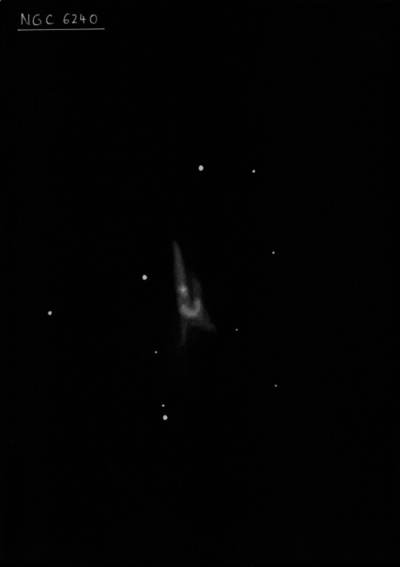
400/500mm - 17.5" (6/8/91): fairly faint, small, elongated 2:1 SW-NE, even surface brightness. A mag 13 star is at the NE edge 0.6' from center.
600/800mm - 24" (7/22/14): the Rumpled Starfish appeared fairly faint to moderately bright, moderately large, irregular but roughly elongated 3:2 SSW-NNE, ~60"x40", though it increased in size with averted vision. The surface brightness is irregular, with a mottled texture. The brightest portion had an offset nucleus or knot on the east side. On the northeast side, a faint narrow wing extended to the north. A very short extension was also glimpsed on the southeast side. A mag 13.5 star is 0.6' NE and a mag 15.7 star is 50" SSE of center.
24" (8/15/12): this irregular galaxy appeared fairly faint, moderately large, elongated 2:1 SSW-NNE, ~1.0'x0.5', broad concentration with a slightly brighter core. The shape is unusual as the NNE end is narrow, like an edge-on, while the south-southwest end appears wider. With careful viewing, a very faint extension branches south from the central region, creating a forked appearance with the brighter portion trending SSW. A mag 13.5 star is 0.6' NE and a mag 15.5 star is 0.8' SE of center.
900/1200mm - 48" (4/6/13): NGC 6240, a highly disrupted merger, appeared fairly bright, moderately large, elongated 3:2 SSW-NNE, ~1.2'x0.8', irregular shape! A prominent, thin extension or spike extends 4:1 or 5:1 to the NNE from the central region. This wing is sharply defined and narrow. A short, bright, broader extension juts out to the SSW, in the opposite direction of the NNE wing. Finally, a faint short wing (~15"x5") extends south from the central region on the east side (on the DSS, this branch curves at the south end). A mag 13.5 star is 30" E, a mag 15.5-16 star is 0.8' SSE and a 12" pair of mag 13.5/15 stars lies 1.5' S.
Notes by Steve Gottlieb
IC 4665
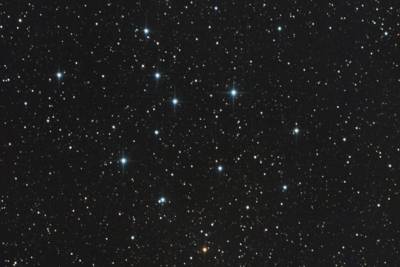
Philippe de Chéseaux discovered IC 4665 in 1745-46. Although his list of nebulae was presented to the Académie des Sciences in 1746 it was not generally known until published by Bigourdan in 1892. John Bode independently discovered the cluster around 1782 and as well as Caroline Herschel on 31 Jul 1783. Solon Bailey also found the cluster on a photographic plate in 1896 using a 1" (f/13) Cook lens at the Arequipa station. The discovery was reported in the 1908 "A Catalogue of Bright Clusters and Nebulae" (Annals of Harvard College Observatory, Vol LX, No. VIII) and Bailey was credited with the discovery in the IC.
200/250mm - 8" (5/80): very bright, very large, overfills 100x field (40'), scattered, includes ∑2212 = 8.5/9.0 at 3". Naked-eye cluster with averted vision (1.3° NNE of mag 2.8 Beta Oph) and bright and resolved in 10x50 binoculars.
Notes by Steve Gottlieb
NGC 6401
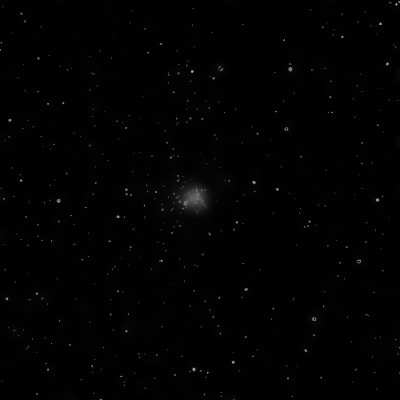
William Herschel discovered NGC 6401 = H I-44 = h1982 = h3697 on 21 May 1784 (sweep 222) and recorded "cB, pL, having a kind of nucleus towards the following side." On 26 May 1786 (sweep 566), he called it "pB, gbM, L, r, some of the stars visible." From the Cape of Good Hope, John Herschel logged "pB; R; vgbM; 25"; a * 13m involved, following the centre."
Sven Cederblad catalogued this globular as the nebula Ced 149. This incorrect classification is probably from Julius Scheiner, who gave its spectrum as gaseous (before 1912) at the Potsdam Observatory.
200/250mm - 8" (6/27/81): faint, small, round, compact, diffuse. A single bright mag 12-13 star is involved.
400/500mm - 17.5" (7/27/92): fairly faint, small, round, 1.5'-2.0' diameter. Unusual appearance as a mag 12 field star is embedded southeast of the core within the halo. No other resolution was seen and the globular has a very weak concentration.
Notes by Steve Gottlieb
NGC 6316
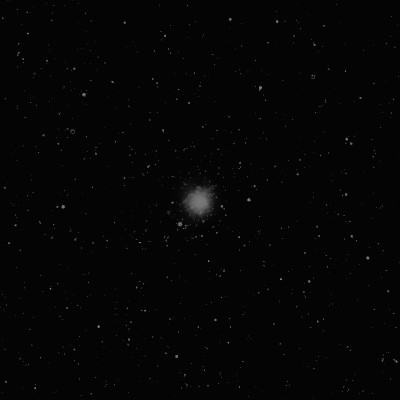
William Herschel discovered NGC 6316 = H I-45 = h3671 on 24 May 1784 (sweep 224) and recorded "B, R, mbM, but the brightness decreasing very gradually. A faintish dusky red colour is still perceptible. It is a perfect miniature of the former miniature [NGC 6293, which is itself a miniature cluster of the 19th of the Connoissance des Temps." So he recognized NGC 6316 as a distant globular.
Dunlop probably observed the globular on 13 May 1826, recording "a very small faint round nebula, about 8" or 10" diameter, bright in the centre. There is a very small star south of the nebula, distant about 10" from it, but it is not involved or connected with the nebula." Observed once, and his position is 36' too far east-southeast, so his identification is not certain.
JH made two observations from the Cape of Good Hope. On 30 Jul 1834 he recorded "globular, B, R, gbM, resolvable, 90", has 2 small stars very near." On a later sweep he logged "globular, pB, S, R, pgvmbM, 2', resolved into stars 16..17th mag."
400/500mm - 17.5" (8/27/92): moderately bright, fairly small, round, 2' diameter, broad concentration with no distinct core. This globular was mottled across the disc but only marginally resolved with a few 16th magnitude stars visible. A brighter mag 12 field star is off the SE edge by 1' and a mag 13 field stars is at the SW side and another 2' W of center.
Notes by Steve Gottlieb
NGC 6356
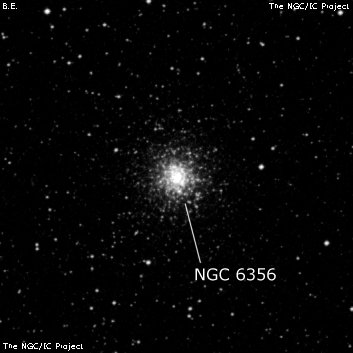
William Herschel discovered NGC 6356 = H I-48 = h3683 on 18 Jun 1784 (sweep 230) and recorded "a large, bright, round, easily resolvable nebula, bM and the brightness diminishing gradually. It is a miniature of the last [M9, which itself a miniature of M53] and I suppose if I had looked enough I might have perceived some of the stars that compose it." From the Cape of Good Hope, JH recorded "globular, vB; R; vgvmbM; 90" resolved into stars barely resolvable with left eye. A beautiful softly shaded object."
300/350mm - 13.1" (7/5/83): bright core surrounded by a round, even glow. No resolution evident in poor seeing.
400/500mm - 17.5" (7/10/99): this fairly bright globular is ~3.5' in diameter and sharply concentrated with a prominent 1.5' core. The core appears slightly elongated N-S, although the halo is circular or slightly elongated WSW-ENE. At 220x the globular appears lively and mottled but there is no obvious resolution. At 280x and especially 380x, the edge of the halo is very ragged and the surface extensively mottled. Around the periphery some threshold stars pop in and out of view, particularly on the south side.
Notes by Steve Gottlieb
NGC 6304
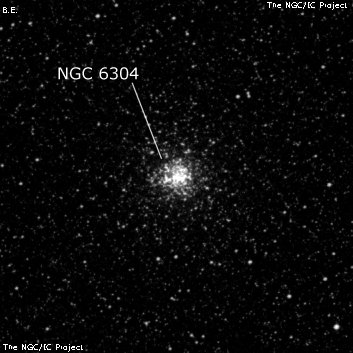
William Herschel discovered NGC 6304 = H I-147 = h3670 on 30 Apr 1786 (sweep 559) and recorded "vB, R, gmbM, between 2 & 3' dia. A very pretty object. A miniature of M62." His position is accurate. JH made two observations from the Cape of Good Hope and described the cluster on sweep 478 as "B; R; at first s, the vgvlbM; brighter part 2' diam; but there is a much fainter portion which extends a good deal further; stars 16-17 mag."
400/500mm - 17.5" (8/27/92): fairly bright, moderately large, slightly elongated E-W. The brightest portion is 2' diameter although a very faint halo increases the diameter to 3'-3.5'. Appears flattened on the south or southeast side. There was no significant central condensation although the central region was very mottled and a few faint mag 15-15.5 stars popped in and out of view. Within the faint halo 10-20 very faint mag 15-16 stars are just resolved.
Notes by Steve Gottlieb
NGC 6235
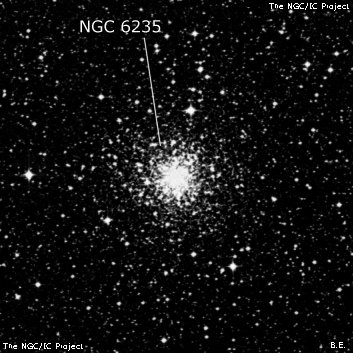
William Herschel discovered NGC 6235 = H II-584 = h3653 on 26 May 1786 (sweep 566) and recorded "pB, cL, gbM, easily resolvable. No doubt that it consists of stars." His position is accurate. John Herschel made the single observation "pretty compressed; S; 2'; rather triangular than R; mbM; resolved into stars 14...16m."
400/500mm - 17.5" (6/8/91): fairly bright, small, 3' diameter, mottled. A few stars are resolved at the edges of the halo including a fairly prominent mag 14 star at the east edge of the halo and another mag 14 star at the west edge of the core. The remaining resolved stars are mag 15 or fainter. The core is elongated N-S. The globular has an irregular scraggly halo due to unresolved star lanes. Located within a triangle of three mag 12-13 stars.
600/800mm - 24" (8/29/19): unusual observation of NGC 6235 with Jupiter just 8' of the globular and Callisto superimposed on the outer south portion of the halo of the globular! Using 260x, with Jupiter off the edge of the field and Callisto resolved as an obvious 1.3" disc, the core of NGC 6235 was seen as a small, hazy patch and the halo was occasionally seen as a low surface brightness glow.
Notes by Steve Gottlieb
NGC 6284
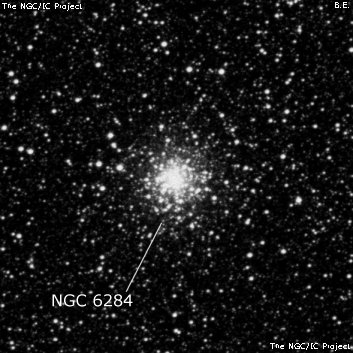
William Herschel discovered NGC 6284 = H VI-11 = h1976 = h3665 on 22 May 1784 (sweep 223) and recorded "a cluster of stars, in respect of the size of the whole, as well as the distance and magnitude of the stars in it, a good miniature of the preceding. The colour of the stars also preserve a faint red; about 1.5 or 2' in diam. It may be called the next step to an easily resolvable nebula." He later commented "It is a good miniature of the 19th of the Connoiss. not only with respect to the size of the cluster, but also with regard to the mutual distance the reduced magnitude of the stars of which it consists." From the CGH, JH recorded "globular cluster; B; R: gbM; diam = 7.0s; resolved into stars 16m."
300/350mm - 13.1" (6/19/82): very small intense core, fainter halo with a few faint stars resolved over a mottled haze.
400/500mm - 17.5" (6/3/00): moderately bright, small, round, 2' diameter, bright core, very small intense nucleus. At 500x, ~12-15 stars are resolved, mostly in the outer halo, and the cluster is very clumpy as if on the verge of more extensive resolution.
Notes by Steve Gottlieb
NGC 6287
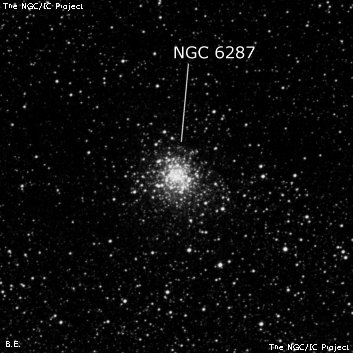
William Herschel discovered NGC 6287 = H II-195 = h3666 on 21 May 1784 (sweep 222) and recorded "pB, cL, iR, r, lbM." JH made the single observation "globular cluster; irreg R; gpm comp M; 3' diam; barely resolved into stars 16...18m." and measured an accurate position.
400/500mm - 17.5" (6/8/91): fairly bright, irregular, 3' diameter, mottled but not resolved at 280x. The core is elongated SW-NE. Two very faint unresolved star lanes stream to the north and east from the core giving the appearance of a tail.
Notes by Steve Gottlieb
NGC 6342
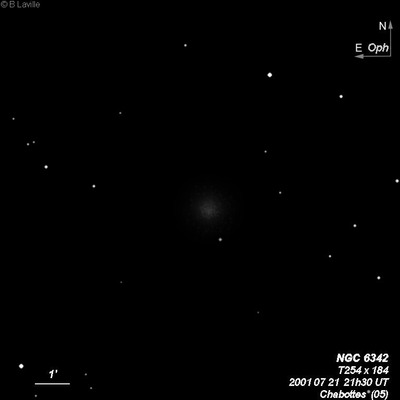
William Herschel discovered NGC 6342 = H I-149 on 28 May 1786 (sweep 569) and recorded "cB, lE, pS, easily resolvable." His position is at the northwest edge of the globular.
Pietro Baracchi observed the GC on 3 Sep 1885 with the Melboure telescope and showed a separate small clump or knot on the NE side.
400/500mm - 17.5" (7/27/92): moderately bright, fairly small, 2' diameter with an irregular outline, increases to fairly well-defined bright core, mottled. A mag 12 is just off the south tip and a very faint extension or lane extends towards this star. One or two very faint stars mag 14.5-15 are at the NE edge. A less well-defined extension to the SW includes one or two threshold stars. The cluster has a lively appearance but there was no additional resolution.
Notes by Steve Gottlieb
NGC 6366
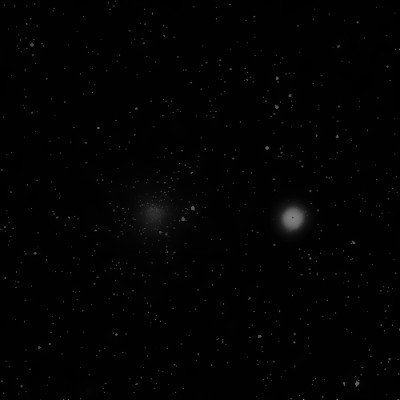
Friedrich August Winnecke discovered NGC 6366 = Au 36 on 12 Apr 1860 with a 3-inch comet-seeker at the Pulkovo observatory and noted "faint, 2 to 3' diam, no significant central brightening." Auwers included it in his 1862 catalogue of new nebulae.
200/250mm - 8" (6/27/81 and 5/21/82): large, very diffuse, unresolved. Located 15' E of a mag 4.5 star that detracts from viewing.
300/350mm - 13.1" (7/5/83): large, diffuse, very weak concentration. About a dozen faint stars are resolved over a hazy background. Located 17' E of 47 Ophiuchi (V = 4.5).
13.1" (6/19/82): few faint stars resolved over a large, hazy region.
400/500mm - 17.5" (7/20/98): at 220x appears as a diffuse irregular glow, ~4' diameter, with only a weak concentration. Two mag 9 and 10 stars are off the west side, the nearest is less than 4' from center and a closer pair of mag 11.5-12 stars [45" separation] is at the south edge. There are perhaps a half dozen faint but obvious stars visible over the ill-defined glow including a couple of mag 14 stars 2' S of center, one a similar distance east of center and an addition pair on the SE side. About a dozen stars are visible with careful viewing. At 280x, the cluster is pretty clumpy and starting to really break up into numerous very faint stars. Roughly two dozen stars can be glimpsed with averted vision, many near the threshold of visibility. The full extent of the cluster is difficult to trace but extends beyond the central 4' region.
Notes by Steve Gottlieb
NGC 6384
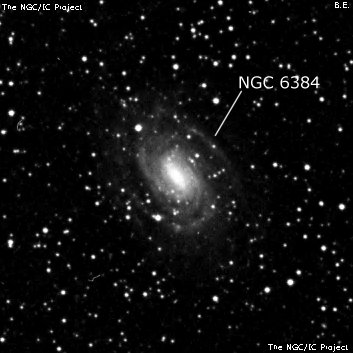
Albert Marth discovered NGC 6384 = m 339 = St II-14 on 10 Jun 1863 and noted "pB, S, vlE." This is the brightest galaxy that Marth discovered, although his position is 4' too far north. Heinrich d'Arrest independently rediscovered NGC 6384 on 8 Apr 1866 with the 11-inch refractor at Copenhagen. In addition, Édouard Stephan found it again on 19 Jul 1870 and reported it new in list II-14.
200/250mm - 8" (6/22/81): faint, diffuse, slightly elongated, brighter core.
400/500mm - 17.5" (7/20/90): moderately bright with a large core slightly elongated SSW-NNE, broad moderate concentration, large faint halo. Two mag 12 stars are at the SE and NE ends 1.3' and 1.7' from center, respectively.
600/800mm - 24" (8/14/15): at 260x; fairly bright, fairly large, elongated 3:2 SSW-NNE. There are three distinct zones. Towards the center is a sharply concentrated, bright, elongated 2:1 nucleus. The nucleus is surrounded by an oval central region, roughly 1.5'x1.0'. The central region is surrounded by a large, very low surface brightness halo, extending ~4.0'x2.5'. Although spiral structure was not seen, the outer regions were noted as irregular. A mag 12.5 star is on the northeast side of the halo, 1.8' from center, and a mag 13.3 star is 1.3' SE of center.
Notes by Steve Gottlieb
IC 4634
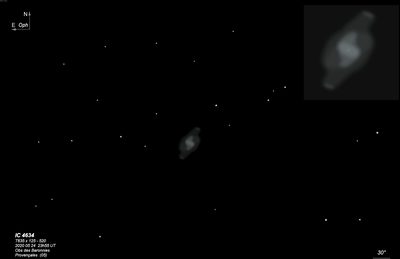
Williamina Fleming discovered IC 4634 = Fleming 72 in 1894 on a Harvard objective prism plate.
Based on Crossley photographs at Lick, Curtis (1918) reported "the oval disk fades out slightly toward the edges; is 10"x7" in short and 11"x9" in long exposures. There are faint ansae in 160-340°, making the total length 20"."
200/250mm - 8" (6/19/82): fairly bright, very small, blue-green color. Appears stellar at 100x and just non-stellar at 200x. A small disc is clearly visible at 400x. Located 5' S of a similar mag 11 star.
400/500mm - 17.5" (7/16/93): very bright compact planetary. A very small disc is visible at 220x. At 410x, appears as a small disc about 10" diameter, slightly elongated. Unusually high surface brightness. Estimate V = 11-11.5. A similar mag 11 star lies 4.6' N.
Notes by Steve Gottlieb
NGC 6293
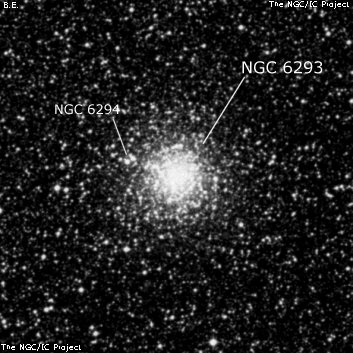
William Herschel discovered NGC 6293 = H VI-12 = h1977 = h3667 on 24 May 1784 (sweep 224) and noted "a miniature cluster of stars of the former cluster [M19]; such as described sweep 223 [NGC 6284], but rather coarser." From the Cape of Good Hope, John Herschel recorded "globular cluster; B; R; psbM; diam 7.0s; resolved into stars 16m."
300/350mm - 13.1" (7/27/84): fairly bright, high surface brightness, compact core, much fainter mottled halo. Between 6-12 very faint stars are resolved in the halo at 360x.
400/500mm - 17.5" (6/6/86): small, compact, 10-20 stars resolved at 286x and on the verge of more extensive resolution.
Notes by Steve Gottlieb
NGC 6355
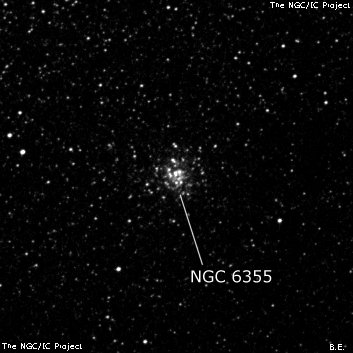
William Herschel discovered NGC 6355 = H I-46 = h3681 on 24 May 1784 (sweep 224) and recorded, cL, rather B, R, r, brighter in the middle and colourless. It was preceded by many vacant fields and I had just been saying that I was upon nebulous ground." From the CGH, JH made the single observation "vF; L; R; gbM; 2' diam; resolved into stars 18m." In early catalogues NGC 6355 was described as an open cluster, with designations Cr 330 and OCl-1036 (Alter et al. 1970).
200/250mm - 8" (5/21/82): faint, small, round, diffuse, no resolution.
400/500mm - 17.5" (7/27/92): fairly faint, fairly small, 2' diameter, slightly elongated N-S, gradually increases to a 1' core. At 280x, appears granular and three or four very faint mag 15 stars are just visible. The brightest two stars are on north side of core.
Notes by Steve Gottlieb
Pal 6
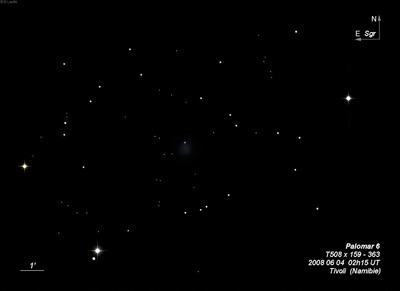
| Type | GC [XI] |
| RA | 17:43:42.0 |
| Dec | -26:13:00.0 |
| major_axis | 72.0'' |
| mag | 11.6 |
| surface_bright | 11.7 |
Cn 3-1
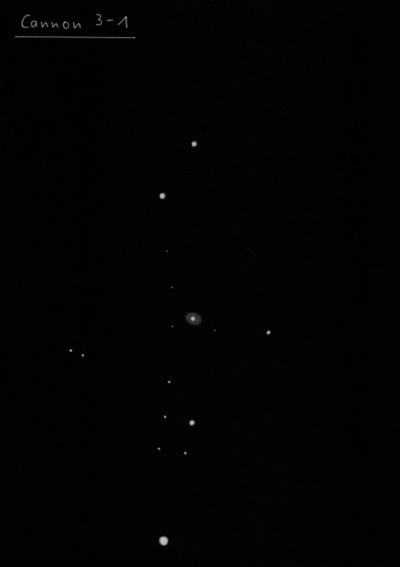
| Type | PN |
| RA | 18:17:34.1 |
| Dec | +10:09:03.0 |
| major_axis | 6.0'' |
| minor_axis | 12.0'' |
| mag | 12.4 |
| surface_bright | 7.2 |
M 2-9
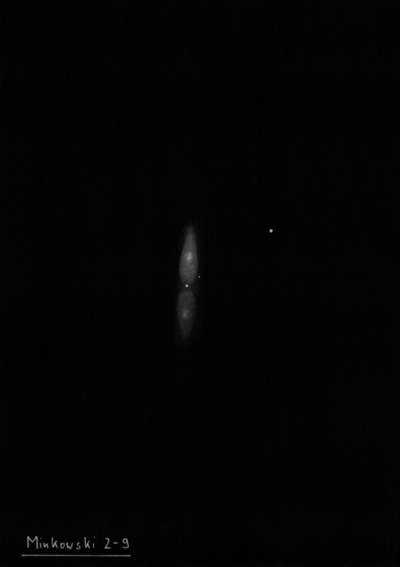
| Type | PN [?(6)] |
| RA | 17:05:38.0 |
| Dec | -10:08:35.0 |
| major_axis | 48.0'' |
| minor_axis | 18.0'' |
| position_angle | 3.0 |
| mag | 13.2 |
| surface_bright | 11.5 |
Na 1
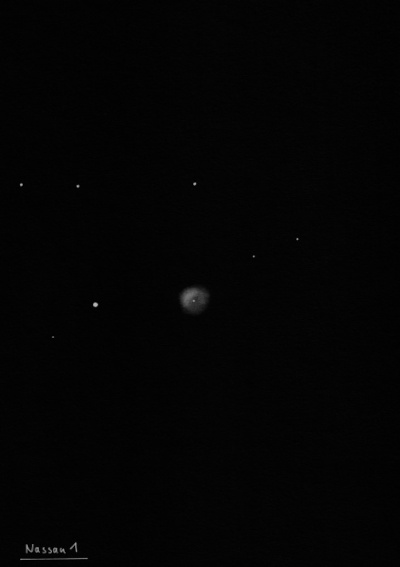
| Type | PN |
| RA | 17:12:51.9 |
| Dec | -03:16:00.0 |
| minor_axis | 48.0'' |
| mag | 13.4 |
| surface_bright | 7.7 |
Pal 15
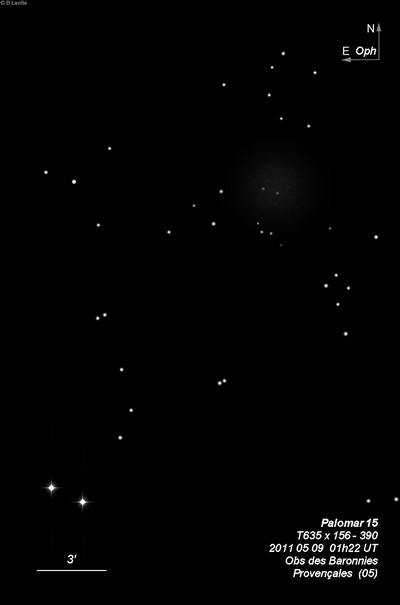
| Type | GC |
| RA | 16:59:54.0 |
| Dec | -00:32:00.0 |
| major_axis | 3.0' |
| mag | 14.0 |
| surface_bright | 16.1 |
K 3-1
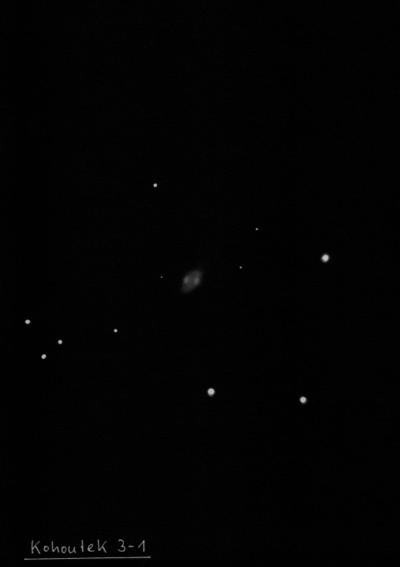
| Type | PN |
| RA | 18:23:21.7 |
| Dec | +03:36:28.0 |
| major_axis | 6.0'' |
| mag | 14.3 |
| surface_bright | 9.0 |
Abell 43
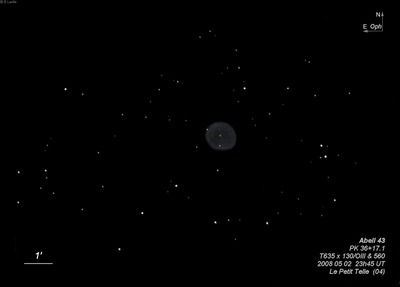
| Type | PN [2c] |
| RA | 17:53:32.3 |
| Dec | +10:37:24.0 |
| major_axis | 78.0'' |
| minor_axis | 72.0'' |
| mag | 14.6 |
| surface_bright | 14.9 |
DeHt 2
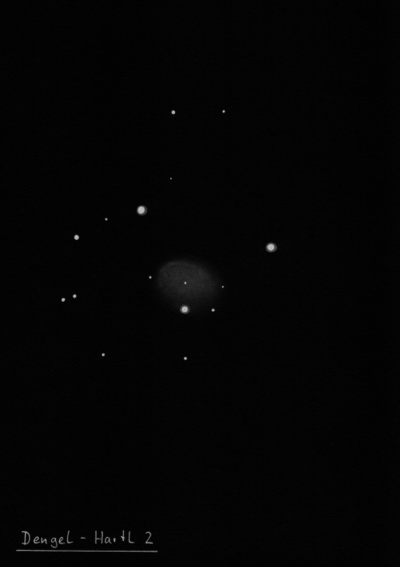
| Type | PN |
| RA | 17:41:40.9 |
| Dec | +03:06:58.0 |
| major_axis | 2.0' |
| mag | 16.3 |
Abell 40
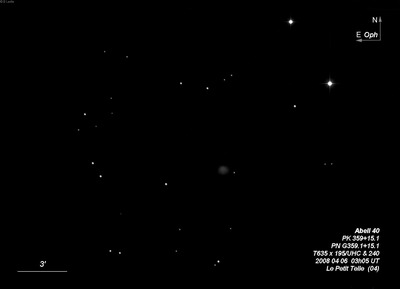
| Type | PN [2b] |
| RA | 16:48:34.5 |
| Dec | -21:00:51.0 |
| major_axis | 30.0'' |
| mag | 16.8 |
| surface_bright | 15.0 |
Abell 42
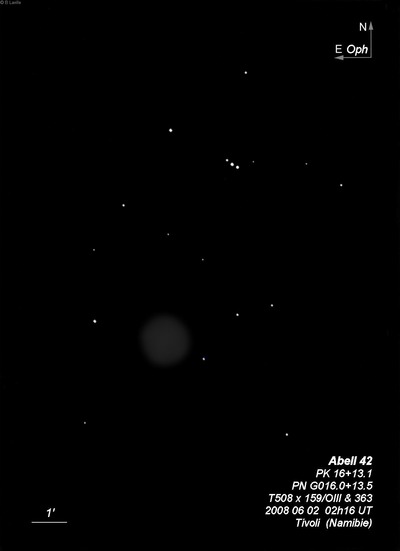
| Type | PN [2b] |
| RA | 17:31:29.1 |
| Dec | -08:19:10.0 |
| major_axis | 60.0'' |
| minor_axis | 60.0'' |
| mag | 17.8 |
| surface_bright | 17.5 |
